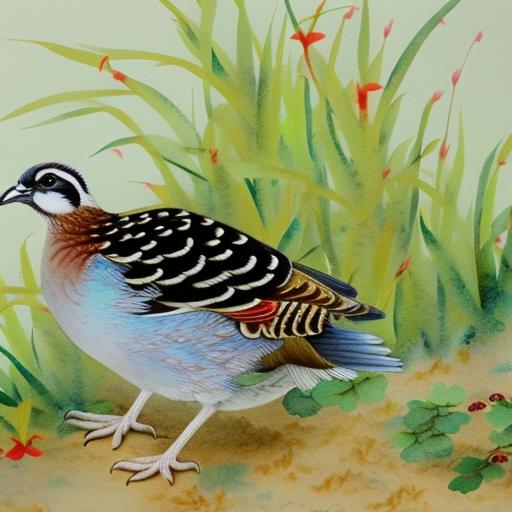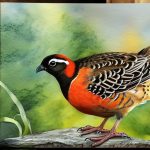Chinese Painted Quail, also known as King Quail or Button Quail, are small, ground-dwelling birds that are native to Asia. They are popular among aviculturists for their colorful plumage and small size, making them an attractive addition to aviaries and bird collections. Chinese Painted Quail are known for their gentle nature and are relatively easy to care for, making them a popular choice for bird enthusiasts of all levels of experience. These quail are known for their distinctive markings, with males sporting a vibrant blue-gray plumage on their heads and necks, while females have a more subdued brown and cream coloring. They are also known for their distinctive call, which is a series of short, sharp whistles that can be quite loud despite their small size. Chinese Painted Quail are social birds and are best kept in pairs or small groups, as they thrive on companionship and interaction with their own kind. They are also known for their active nature, spending much of their time foraging for food and exploring their environment.
Chinese Painted Quail are relatively easy to care for, making them a popular choice for bird enthusiasts of all levels of experience. These quail are known for their distinctive markings, with males sporting a vibrant blue-gray plumage on their heads and necks, while females have a more subdued brown and cream coloring. They are also known for their distinctive call, which is a series of short, sharp whistles that can be quite loud despite their small size. Chinese Painted Quail are social birds and are best kept in pairs or small groups, as they thrive on companionship and interaction with their own kind. They are also known for their active nature, spending much of their time foraging for food and exploring their environment.
Key Takeaways
- Chinese Painted Quail are small, colorful birds that are popular for their beauty and ease of care.
- They reach sexual maturity at around 6-8 weeks of age and can start breeding at this time.
- Signs of sexual maturity in Chinese Painted Quail include crowing, mating behavior, and egg laying.
- Breeding practices should include providing a suitable nesting area and ensuring a balanced diet for the quail.
- Reproductive health and care for Chinese Painted Quail should include regular monitoring for signs of illness and providing a clean and stress-free environment.
Sexual Maturity and Breeding Age
Chinese Painted Quail reach sexual maturity at a relatively young age, typically around 6-8 weeks old. However, it is important to note that while they may be physically capable of breeding at this age, it is generally recommended to wait until they are at least 12 weeks old before allowing them to breed. This allows the birds to fully mature and develop before they begin the demanding process of reproduction. Additionally, waiting until they are a bit older can help to ensure that they are in optimal health and condition for breeding, which can lead to more successful outcomes.
It is important to note that while Chinese Painted Quail may reach sexual maturity at a young age, it is not advisable to breed them until they are at least 12 weeks old. This allows the birds to fully mature and develop before they begin the demanding process of reproduction. Waiting until they are a bit older can help to ensure that they are in optimal health and condition for breeding, which can lead to more successful outcomes. It is also important to consider the overall health and well-being of the birds before allowing them to breed, as breeding can be physically demanding and stressful for the birds.
Signs of Sexual Maturity in Chinese Painted Quail
There are several signs that indicate that Chinese Painted Quail have reached sexual maturity. One of the most obvious signs is the behavior of the birds. Males may become more vocal and display courtship behaviors such as puffing up their feathers and performing a “dance” to attract females. Females may also display receptive behaviors such as crouching down and “presenting” themselves to the males. Additionally, both males and females may become more territorial and aggressive towards other birds, particularly if they are housed in close quarters with members of the opposite sex.
Another sign of sexual maturity in Chinese Painted Quail is the physical appearance of the birds. Males may develop more vibrant plumage and markings, particularly on their heads and necks. Females may also develop a more rounded and plump appearance, particularly in the abdominal area as they begin to produce eggs. It is important to be aware of these signs of sexual maturity in order to properly care for and manage breeding pairs of Chinese Painted Quail.
Breeding Practices and Considerations
When breeding Chinese Painted Quail, it is important to provide them with a suitable environment that mimics their natural habitat. This includes providing plenty of space for the birds to move around and forage, as well as access to suitable nesting sites. It is also important to provide a balanced diet that includes a variety of seeds, grains, and insects to ensure that the birds are receiving the proper nutrition for breeding.
Breeding Chinese Painted Quail can be a rewarding experience, but it is important to be prepared for the demands of breeding and caring for young birds. It is important to provide a suitable environment that mimics their natural habitat, including plenty of space for the birds to move around and forage, as well as access to suitable nesting sites. Additionally, it is important to provide a balanced diet that includes a variety of seeds, grains, and insects to ensure that the birds are receiving the proper nutrition for breeding.
Reproductive Health and Care
When breeding Chinese Painted Quail, it is important to monitor the reproductive health of the birds closely. This includes keeping an eye on the condition of the eggs and ensuring that the birds have access to suitable nesting sites and materials. It is also important to provide the birds with a balanced diet that includes plenty of calcium and other essential nutrients to support egg production and overall reproductive health.
Reproductive health and care are essential aspects of breeding Chinese Painted Quail. It is important to monitor the condition of the eggs closely and ensure that the birds have access to suitable nesting sites and materials. Providing a balanced diet that includes plenty of calcium and other essential nutrients is also crucial to support egg production and overall reproductive health.
Potential Challenges in Breeding Chinese Painted Quail

Breeding Chinese Painted Quail can present several challenges, particularly for inexperienced breeders. One common challenge is ensuring that the birds have access to suitable nesting sites and materials. Additionally, it can be challenging to monitor the reproductive health of the birds and ensure that they are receiving the proper nutrition for breeding. Another potential challenge is managing aggressive or territorial behavior between breeding pairs, particularly if they are housed in close quarters with other birds.
Breeding Chinese Painted Quail can present several challenges, particularly for inexperienced breeders. Ensuring that the birds have access to suitable nesting sites and materials can be challenging, as well as monitoring the reproductive health of the birds and ensuring that they are receiving the proper nutrition for breeding. Managing aggressive or territorial behavior between breeding pairs can also be a potential challenge, particularly if they are housed in close quarters with other birds.
Conclusion and Tips for Successful Breeding
Breeding Chinese Painted Quail can be a rewarding experience for bird enthusiasts, but it is important to be prepared for the demands of breeding and caring for young birds. Providing a suitable environment that mimics their natural habitat, monitoring reproductive health closely, and ensuring that the birds have access to a balanced diet are all essential aspects of successful breeding. Additionally, it is important to be aware of potential challenges such as aggressive behavior between breeding pairs and take steps to manage these issues effectively.
In conclusion, breeding Chinese Painted Quail requires careful consideration and preparation, but with proper care and attention, it can be a rewarding experience for bird enthusiasts. Providing a suitable environment that mimics their natural habitat, monitoring reproductive health closely, and ensuring that the birds have access to a balanced diet are all essential aspects of successful breeding. Additionally, being aware of potential challenges such as aggressive behavior between breeding pairs and taking steps to manage these issues effectively can help ensure a successful breeding experience.
If you’re interested in learning more about the breeding age of Chinese painted quail, you might also want to check out this informative article on how long it takes for chicken eggs to hatch naturally. Understanding the incubation period and hatching process can provide valuable insights into the breeding and reproductive behaviors of quails as well.
FAQs
What is the breeding age for Chinese painted quail?
The breeding age for Chinese painted quail is typically around 2 to 3 months old.
At what age do Chinese painted quail reach sexual maturity?
Chinese painted quail reach sexual maturity at around 6 to 8 weeks of age.
How can you determine the gender of Chinese painted quail?
The gender of Chinese painted quail can be determined by examining their plumage and behavior. Males typically have more vibrant and distinct markings, while females are usually smaller and have more subdued colors.
What is the best age to start breeding Chinese painted quail?
The best age to start breeding Chinese painted quail is around 3 to 4 months old, once they have reached sexual maturity.
Are there any health considerations when breeding Chinese painted quail at a young age?
Breeding Chinese painted quail at a young age can be risky, as it may put additional stress on their still developing bodies. It is important to ensure that they are in good health and have access to proper nutrition before attempting to breed them.
Meet Walter, the feathered-friend fanatic of Florida! Nestled in the sunshine state, Walter struts through life with his feathered companions, clucking his way to happiness. With a coop that’s fancier than a five-star hotel, he’s the Don Juan of the chicken world. When he’s not teaching his hens to do the cha-cha, you’ll find him in a heated debate with his prized rooster, Sir Clucks-a-Lot. Walter’s poultry passion is no yolk; he’s the sunny-side-up guy you never knew you needed in your flock of friends!







